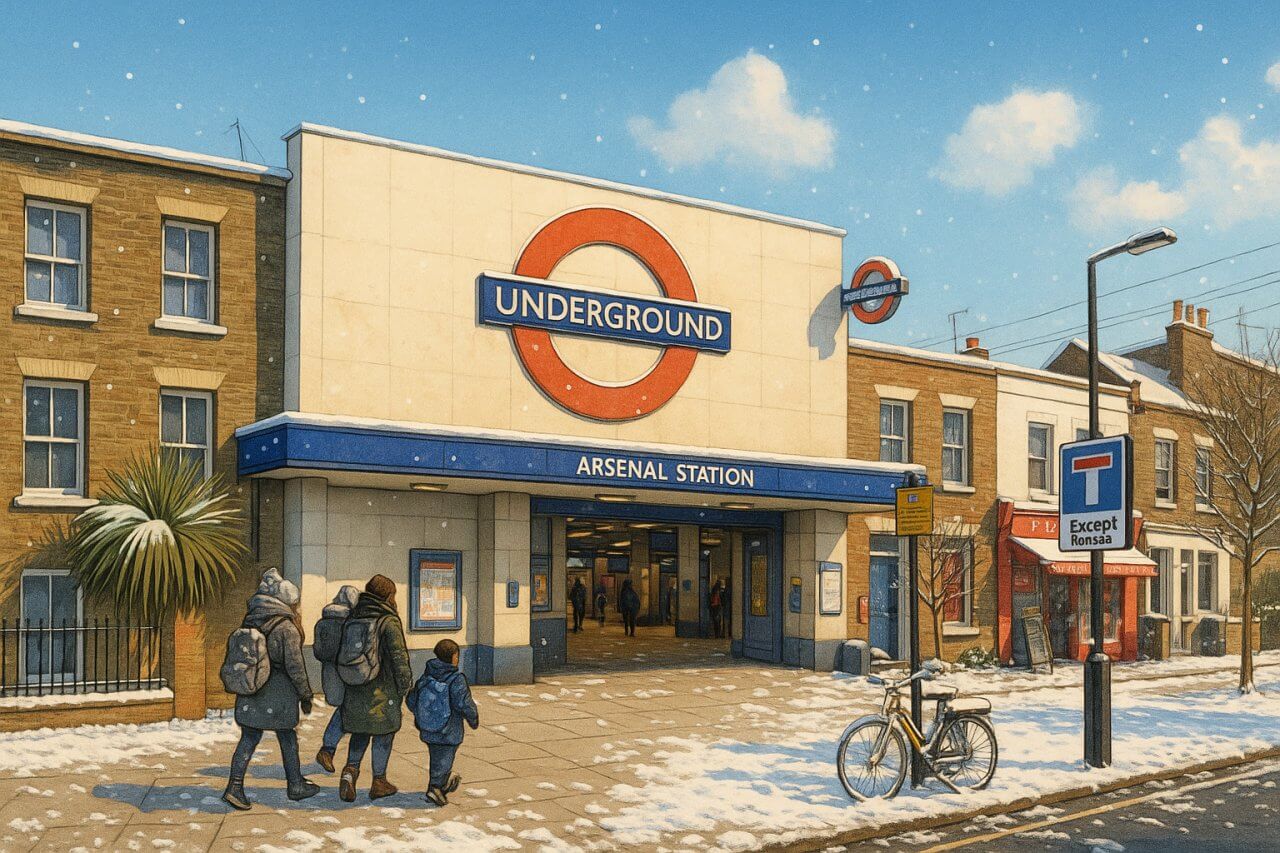
Arsenal Station, London
Arsenal Station is a London Underground station in the north London district of Highbury, best known for its close association with Arsenal Football Club. The station is located on Gillespie Road, with its main entrance positioned between Avenell Road and St. Thomas’s Road. Although modest in appearance, this Piccadilly Line station has a rich footballing legacy and is a landmark for match-going fans on home game days.
Location and Access
The station’s entrance sits on Gillespie Road, a quiet residential street just a short walk from the bustling Holloway Road. There is no grand above-ground building—just a brick-built entrance with a modest frontage. The structure is integrated into the surrounding streetscape and does not contain shops or other amenities, making it somewhat unassuming compared to larger London Underground Stations.
Arsenal Station is approximately 4.5 miles by road from Charing Cross, the traditional centre of central London. Travelling via car or bus can take around 30–45 minutes depending on traffic, while the journey by Tube is more direct and significantly faster.
Services and Connections
Arsenal is served solely by the Piccadilly Line, offering frequent service between north and west London. It lies between Holloway Road (to the south) and Finsbury Park (to the north). Finsbury Park is a major interchange where travellers can connect to the Victoria Line and National Rail services, making Arsenal a convenient local station despite its limited connections.
The station does not offer connections to the Bakerloo Line, Central Line, Circle Line, District Line, Elizabeth Line, Hammersmith & City Line, Jubilee Line, Metropolitan Line, Northern Line, or Waterloo & City Line.
There are no Overground or National Rail services at Arsenal, which differentiates it from larger interchange hubs like the City or City of London stations in the Square Mile.
Historical Background
Arsenal Station originally opened on 15 December 1906 as part of the Great Northern, Piccadilly and Brompton Railway, the forerunner of the Piccadilly Line. At that time, it was named Gillespie Road after the street on which it stands.
In 1932, the station was renamed to Arsenal (Highbury Hill), in honour of the nearby Arsenal Stadium—commonly referred to as Highbury—which had become a major destination. The renaming was proposed by the club's legendary manager Herbert Chapman, who sought to give the station a more direct identity aligned with the football club. By 1960, the suffix “Highbury Hill” was dropped, and it became simply Arsenal.
A Station Uniquely Tied to Football
Arsenal is the only station on the London Underground network to be named directly after a football club, a fact that delights both locals and tourists. On match days, the quiet streets around the station come alive with a surge of red and white jerseys as fans head to the nearby Emirates Stadium, the modern home of Arsenal FC, which replaced Highbury in 2006.
The station has been modestly updated over the years but retains much of its early 20th-century charm. Notably, it still features original tiling and a small number of period details that give a glimpse into the Tube's Edwardian past.
Fun Fact
Arsenal Station is the only Tube station named after a football club, making it a unique pilgrimage spot for fans of the sport. The station even saw increased usage during the club’s most successful years in the late 1990s and early 2000s. Today, it remains an iconic stop for both football fans and curious tourists alike.
Quick Facts
- Station Name: Arsenal
- Location: Gillespie Road, Highbury, north London
- Opened: 15 December 1906 (originally as Gillespie Road)
- Renamed: Arsenal (Highbury Hill) in 1932; simplified to Arsenal in 1960
- Line: Piccadilly Line
- Adjacent Stations: Holloway Road (south), Finsbury Park (north)
- Services: London Underground only
- Nearby Landmarks: Emirates Stadium, Gillespie Park Nature Reserve
- Distance from Charing Cross: Approx. 4.5 miles by road
- Station Building: Modest brick entrance on Gillespie Road
- Fun Fact: Only Tube station named after a football club
References
- Transport for London - Piccadilly Line History
- Arsenal FC Official History
- London Transport Museum - Arsenal Station
Arsenal Station is  on the Map of London Underground
on the Map of London Underground

Painting of Arsenal Station, London (View image in full size)